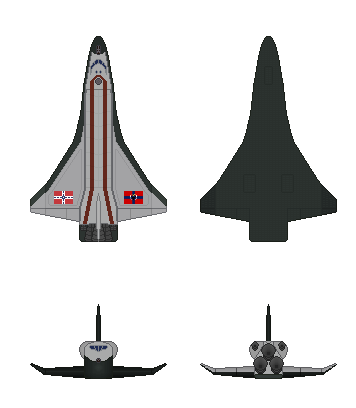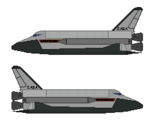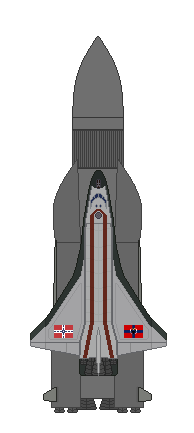Future Shuttle Program
Development of the Independence-class Space Shuttle
The Independence-class space shuttle emerged from CASA's imperative to modernize its aging shuttle fleet, comprising both the Orbiter-class from CASA and the Buran-class from the Nodea Rudav CCCP. Instead of investing billions into refurbishing these shuttles, CASA opted to develop a homegrown alternative to secure the future of its space program. In 2011 CE, Anagonia assembled its top minds to conceive a shuttle with the carrying capacity of the Orbiter and the technological prowess of the Buran-class. Over five years, under the Future Shuttle Initiative (FSI), or Future Shuttle Program (FSP), numerous concept renditions were explored, yielding two promising designs: the Buran-II and the Independence-X.
The Buran-II proposal aimed to enhance existing Buran shuttles with advanced automated systems. Two prototypes, CASA-B-04 Tsunami and CASA-B-05 Blizzard, were modified to showcase the proposed upgrades. Despite initial trials, the Buran-II shuttles fell short of expectations, leading to their retirement after several test launches. However, their modernizations paved the way for the continued use of Tsunami and Blizzard in CASA's fleet.
In contrast, the Independence-X initiative represented a bold departure from conventional shuttle designs. Inspired by the Buran and the Orbiter's cargo capacity, designers sought to create a fully Anagonian variant. Despite concerns during initial testing, a prototype, the FSI-X Independence-X, was constructed and demonstrated impressive capabilities. Though a subsequent unmanned launch exposed reentry issues, the automated systems salvaged the mission, underscoring the prototype's potential.
To address the shortcomings identified during testing and meet FSP standards, designers from both projects collaborated. After two more years of intensive work, the joint team unveiled the Independence-class Space Shuttle and Sovereignty Launch Vehicle. Extensive research and testing ensured compliance with FSP criteria, culminating in the rollout of the CASA-I-01 Independence prototype on August 7th, 95 AUR.
The Independence-class shuttle integrated proven features of the Buran and Orbiter, including an elongated nose for additional systems and crew compartments. Notable enhancements included extended cargo capacity, detachable boosters for lunar missions, and advanced mechanical and electronic systems. Safety measures, such as detachable crew sections for emergencies, further underscored CASA's commitment to crew welfare.
The Sovereignty Launch Vehicle, designed for 100% reusability, featured booster parachutes and self-landing capabilities. Though initial proposals suggested ground landings, CASA opted for water landings to ensure safety.
On February 14th, 2022, the CASA-I-01 Independence and Sovereignty Launch Vehicle embarked on their inaugural flight. Following successful aerial trials, the Independence's unmanned test flight validated its systems, while the Sovereignty demonstrated flawless performance, culminating in a safe water landing.
Subsequent crewed missions, Independence Two and Independence Three, confirmed the shuttle's capabilities, leading to full-scale production. The original prototype, CASA-I-01 Independence, underwent retrofitting for active service, cementing the Independence-class as a cornerstone of CASA's space program.
Typical Functions
The CASA Independence-class Space Shuttle was designed to take over and fulfill a variety of functions that are shared by both the CASA Orbiter and Nodea Rudav CCCP Buran orbiter variants. Those functions and operations include cargo ferrying to orbit, deployment of contracted private industry and government assets, deployment of additional space station modules and space station maintenance, covert special military operations with applicable equipment installed in cargo bay, CASA crew transport to and from operational space stations, crew and cargo transport to Lunar facilities from orbit, and a variety of other functions that serve the interests of both CASA and the Confederate States.
Special Functions
Due to the specialized nature of the Independence-class Space Shuttle, experimental system designs can be installed to further understand and push the boundaries of modern science and technology. Traditionally, however, the shuttle itself is intended ferry a specific module or probe to orbit that has these specified designs installed and will act as mothership and home base for any scientific inquiry and observation.
Launch Procedures
The Independence-class Space Shuttle is designed to support the CASA Orbiter launch stacks and the Buran-Energia launch rocket. In the event the shuttle utilizes either of these launch vehicles, launch and standard orbital maneuvers are similar to its Orbiter and Buran Shuttle counterparts with little deviation with the exception of maneuvers specifically designed to counter weight and other unique factors. As with any nominal launch, the Shuttle and Launch stack will be launched from the required spaceport, followed by conditional adjustments during launch such as relegated thrust due to dynamic pressure and a 180-degree turn to align the craft to specified vectors. Following booster separation, the remaining components of the launch stack would be discarded prior to orbital events, wherein the shuttles internal fuel will resume the rest of the course. The Independence-class is designed to hold additional fuel reserves for both emergency and orbital procedures, with the inclusion of smaller fuel pods and boosters should the need require it. However, these two launch vehicles are not intended to be the primary method of supporting a shuttle launch.
The Independence-class Space Shuttle is intended to be mounted primarily on the Sovereignty Launch Vehicle. The launch procedures are essentially similar to its Orbiter and Buran counterparts, with little variation with the exception of preplanned orbital insertions and other unique factors. The only difference between the three options is that of the intended reusability of the Sovereignty Launch Vehicle, which adds additional steps for the launch vehicle to perform to ensure safe retrieval of the components. The unique steps for this primary method of launch are explained below.
Sovereignty Launch Vehicle/Independence-class Shuttle Launch Procedures
The Sovereignty Launch Vehicle, paired with the Independence-class Space Shuttle, undergoes meticulous pre-launch preparations and procedures to ensure a safe and successful mission. Positioned vertically on the Shuttle Launch Pad, the launch sequence follows a carefully orchestrated series of steps, incorporating advanced safety protocols and automated systems oversight.
Pre-Launch Phase:
- Prior to launch, the Launch Vehicle is fueled on the pad, with an allocated time dedicated to this critical phase.
- Startup procedures are initiated, activating the automated systems and conducting comprehensive checks to ensure readiness.
- Technicians verify connectivity with ground control and ensure seamless communication between onboard systems and ground relays.
Launch Initiation:
- Launch countdown commences, with emergency ejection systems primed for activation at the 20-second mark.
- In the event of a catastrophic failure, the automated system initiates crew compartment separation and ejection to ensure crew safety.
- At the 18-second mark, the main support umbilical is retracted, clearing the launch path.
- Water spray begins at the 12-second mark to mitigate the effects of flame plumes, and all supporting umbilicals are released.
- At the 10-second mark, the Launch Vehicle's main engines ignite, followed by booster release configurations at the 5-second mark.
- Solid rocket booster ignition initiates at the 2-second mark, with the entire launch system lifting off at the 0-second mark.
Emergency Procedures:
- In the event of a malfunction between the 20-second to 2-second mark, the automated system halts the ignition sequence and prevents solid rocket booster firing.
- Post-2-second mark emergencies prompt various responses, including crew compartment ejection or controlled vehicle separation and landing.
- Minor emergencies trigger trajectory adjustments for safe retrieval, while major incidents necessitate launch vehicle detonation over the ocean.
Orbital Insertion and Beyond:
- Following a successful launch, the Launch Vehicle follows a predetermined trajectory, with booster separation and descent back to Earth.
- The Primary Launch Vehicle separates from the shuttle, initiating a boost-back sequence for safe ocean landing.
- The Independence-class Shuttle utilizes remaining fuel for orbital insertion and positional maneuvers.
- Fuel reserves accommodate mission requirements, with options for Earth or Lunar orbit missions, and refueling capabilities for extended operations.



